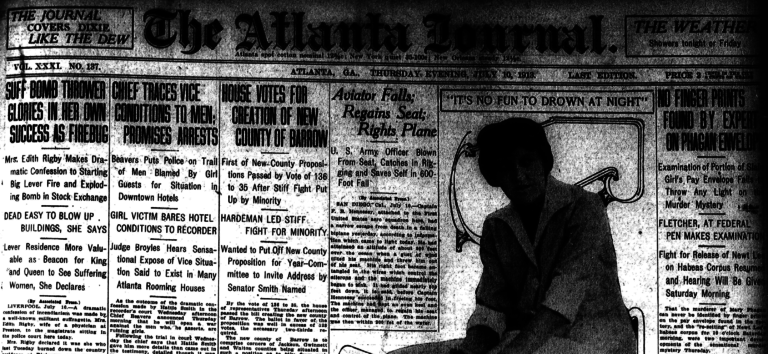No Finger Prints Found by Expert on Phagan Envelope
The Atlanta Journal
Thursday, July 10, 1913
Examination of Portion of Slain Girl’s Pay Envelope Fails to Throw Any Light on the Murder Mystery
FLETCHER, AT FEDERAL PEN MAKES EXAMINATION
Fight for Release of Newt Lee on Habeas Corpus Resumed and Hearing Will Be Given Saturday Morning
That the murderer of Mary Phagan can never be identified by finger prints on the pay envelope found in the factory, and the “re-setting” of Newt Lee’s habeas corpus for 10 o’clock. Saturday morning, were two important developments of the sensational murder mystery Thursday.
According to Attorney Bernard L. Chappell, of Graham & Chappell, counsel for the negro night watchman, fifty witnesses among them the negro James Conley, confessed accomplice, and Leo M. Frank, accused of the crime, will be subpenaed for the habeas corpus hearing.
It is known that the solicitor general, Hugh M. Dorsey, will oppose the release from the Tower of Lee on the ground that he is a material witness.
Counsel for Frank will take no part in the fight to secure the release of Lee, but Attorney Reuben R. Arnold stated when the case was postponed that he would oppose any effort to bring Frank into the court for the habeas corpus hearing.
It is said that the counsel for Frank will oppose bringing him to the court on the ground that it is not lawful to force a defendant to give any testimony which relates to or bears on the crime for which he is to be tried.
This, as a result, will prevent the much talked of meeting of Frank and Conley.
According to the attorney for Lee, subpenas will be issued to the many detectives who have worked on the case, to the solicitor general and to the foreman of the grand jury that failed to indict Lee.
EXAMINED BY EXPERTS.
The part of a pay envelope, bearing across it the name of Mary Phagan, which was found in the pencil factory seevral [sic] weeks after she was murdered, is in the possession of Pinkerton detectives, who on Thursday took it to the federal prison in order that L. J. Fletcher, the government finger print expert, might examine it.
The paper was curled, as if some one had rolled it in his hands, when it was found in the factory, and has been carefully preserved and handled only when resting on another sheet of paper.
For that reason it was thought that a finger print might aid in identifying the girl’s slayer.
Every known method of raising or developing finger prints on paper was used by the prison expert, however, without any trace of a finger print showing.
While it was thought Wednesday that both the state and the defense knew of the finding of the slip of paper, prosecuting officials all denied Thursday that they had heard anything about the find until they read The Journal’s exclusive story.
Attorneys for the defense, however, admitted that they have known for a week that the slip of paper was found in the factory.
WHAT PROSECUTION SAYS.
Prosecuting officials doubt that the part of a pay envelope found so long after the tragedy was really the envelope which Mary Phagan received as the factory on the day she met her death.
It could have been an old envelope (it bore no date), or some factory employe [sic] might have carelessly written the girl’s name on a part of an envelope and dropped it on the floor long after the crime, they say.

